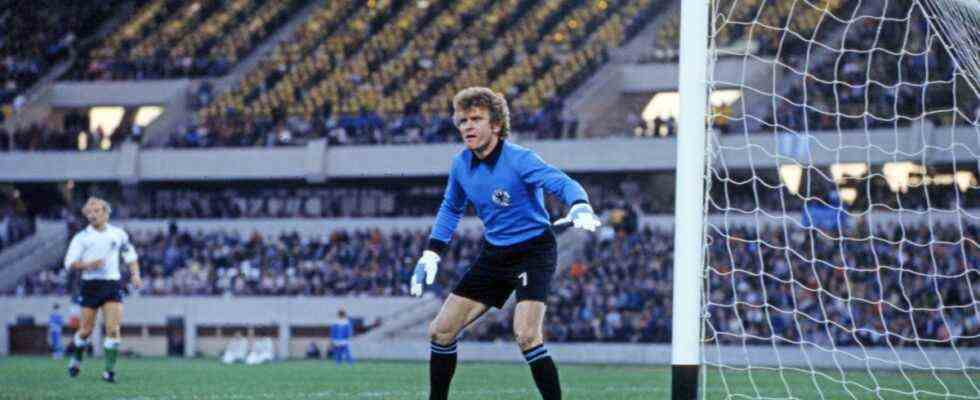Andreas Bernard has an amazing memory, or he must have written down the smallest details – even as a child – because he still knows everything about a football that has long since disappeared. That the goalposts at the 1978 World Cup in Argentina were painted black at the bottom, like a crape on the beams, for example. Or that the goal nets were stretched further back than in the Bundesliga, the ball had to be freed by the keeper in some stadiums at this World Cup, almost like a kind of fishing net, at least as I remember it. “Thinking about childhood means thinking about football,” writes Bernard, for whom the first consciously experienced World Cup was that in South America. For others, it was Spain 1982, the World Cup of Brazil’s incomparably yolk-yellow jerseys. Or Mexico 1986: How the stadium loudspeaker in the Aztec Stadium cast a shadow on the center circle, and the shadow looked like the outline of a giant straw star.
Bernard, born in 1969, when he thinks of his childhood, thinks of the early battles he witnessed on television, but he also thinks of the battles he took part in as a talented left-footer, at a club, where else in the E-youth a coach said: “You can calm the game.” A poisoned praise, behind it the message: You are not the fastest. So: Soccer is the game of life. Even on the soccer fields of the early years, stone deserts at first and then a field that had a rubber surface and was therefore called rubber: the boys played against each other on the rubber, and although all these games were played in Munich before they even belonged to a club, kicked Bernard in an MSV Duisburg jersey, he liked the blue and white crossbars. The parents had ordered the jersey from a retailer who was then in the trade journal table football advertised. It came in the mail after weeks of waiting.
In the past, dream goals had to survive in the memory, today they are on YouTube forever
At this point, where it comes to the procurement of the favorite jersey, it becomes clear what has changed, among other things: that everything that the football player and football lover needs is now constantly and permanently available. The jerseys of all clubs in the world in the internet fan shops, lightning-fast delivery guaranteed. And all the dream goals that you used to see in the sports show and then had to survive in your memory because you might only be able to admire them again when you look back at the year or never at all – you can see them now, as soon as they’re scored, until the End of Days on Youtube. The black areas on the goalposts in Argentina have also been demystified as a silent protest against the military junta – although there are also arguments against this theory. In the meantime, however, the Fifa rule book also applies in Argentina: “Posts and crossbars are white.”
Bernard, who teaches cultural sciences at the University of Lüneburg, always playfully expands the field in his fine text when he thinks about football and its treasure chests and archives, which are now permanently open on the Internet. When it comes to football, it’s always about much more than just football: “Would it be Uwe Johnson’s anniversaries What if high-speed WiFi and websites like antiqueprintsandmaps.com in Manhattan in the late 1960s brought the Mecklenburg landscape back to life before the Second World War? The greatest memoirs have wrested from an elementary deficiency, and it is not yet decided what consequences the digital paradises of visualization will have for literary writing.”
Andreas Bernard: We went out and played football. Klett-Cotta, Stuttgart 2021. 160 pages, 20 euros.
Of course, “We went out and played football” (a Beckenbauer quote ennobled by the invitation to confess) gathers a lot – and possibly also a lot of useless – nerd knowledge. But when you’ve accumulated a lot of it yourself, reading it gives you the comforting feeling of not being alone. Much of what one remembers from childhood remains a mystery that is difficult to verify without anyone knowing about it.
Myths, riddles: why did Gerd Müller change his appearance after the 1974 World Cup?
The author of this review, for example, remembered for many years of his life a character from children’s television who looked like an aging mouse with a full gray beard and whom he had saved as “Meikel Mausegreis”. Others, clearly the majority, remembered “Meikel Katzengreis”, and how one animal was connected to the other only brought to light the internet when it finally got going. Meikel Mausegreis really existed, in the distant year 1975, but after a few broadcasts he had to be redecorated from an old mouse to an old cat, because one wanted to prevent confusion with the “broadcast with the mouse”. So the whole thing was kind of a trademark case.
Appropriately, Andreas Bernard recalls the two versions of Gerd Müller. The miller of the early 1970s, up to about WM ’74, wore longer hair, sometimes a mustache, the nation’s bomber could actually look like a South American freedom fighter. The future miller had a decent hairdo and this branch manager’s full beard, he seemed more sluggish, on the Panini collection picture “Euro Football” 1976/77 he already looks like that and after that actually always. “Who knows why he underwent such a change in his appearance?” asks Bernard, which can probably no longer be answered post mortem. But a more important, lasting theme: how images trace the boundary between unconscious and conscious life. Maybe it’s the case that the earlier, anarchist miller still came from the fantasy world of the time before one’s own view. While the later Müller was the one you saw playing with your own eyes and was a little disenchanted as a result.

